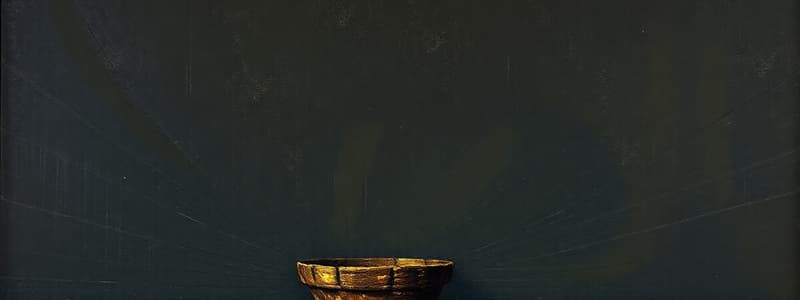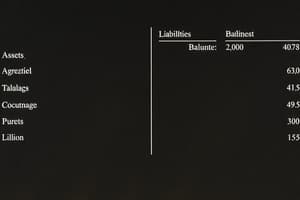Podcast
Questions and Answers
What is the impact on liabilities when a company purchases equipment for cash?
What is the impact on liabilities when a company purchases equipment for cash?
- Increase
- Repayment liability
- Decrease
- No change (correct)
What happens to shareholders' equity when a company incurs an expense on account?
What happens to shareholders' equity when a company incurs an expense on account?
- Increases by the expense amount
- Increases by accounts payable
- Decreases by the expense amount (correct)
- No change
Which transaction affects both assets and liabilities equally?
Which transaction affects both assets and liabilities equally?
- Purchase of equipment on credit (correct)
- Sale of equipment for cash
- Collection of accounts receivable
- Payment of a liability
How does converting a debt into share capital impact shareholders' equity?
How does converting a debt into share capital impact shareholders' equity?
What is the effect on assets when a company makes a payment on a liability?
What is the effect on assets when a company makes a payment on a liability?
What is a correct definition of fixed assets?
What is a correct definition of fixed assets?
Which category of liability refers to obligations that are expected to be settled over a longer period?
Which category of liability refers to obligations that are expected to be settled over a longer period?
Owners' equity represents which of the following?
Owners' equity represents which of the following?
What does an increase in owners' equity typically indicate?
What does an increase in owners' equity typically indicate?
Which of the following statements is true regarding contingent liabilities?
Which of the following statements is true regarding contingent liabilities?
What are current assets primarily characterized by?
What are current assets primarily characterized by?
Which of the following transactions would cause a decrease in owners' equity?
Which of the following transactions would cause a decrease in owners' equity?
What is the primary function of a balance sheet?
What is the primary function of a balance sheet?
Which of the following represents a fundamental equation of accounting?
Which of the following represents a fundamental equation of accounting?
What is considered the residual value of a company?
What is considered the residual value of a company?
In which order are assets listed in the US presentation?
In which order are assets listed in the US presentation?
Which of the following components is NOT part of liabilities?
Which of the following components is NOT part of liabilities?
What does the term 'double entry system' imply?
What does the term 'double entry system' imply?
Which of the following is a component of total assets in the French presentation?
Which of the following is a component of total assets in the French presentation?
What must always be true for the balance sheet?
What must always be true for the balance sheet?
Which of the following statements is correct concerning the structure of the balance sheet?
Which of the following statements is correct concerning the structure of the balance sheet?
Flashcards
Balance Sheet
Balance Sheet
A financial statement that shows a company's assets, liabilities, and owners' equity at a specific point in time.
Assets
Assets
Resources controlled by a company that are expected to provide future economic benefits.
Liabilities
Liabilities
Financial obligations or debts that a company owes to others.
Owners' Equity
Owners' Equity
Signup and view all the flashcards
Fixed Assets
Fixed Assets
Signup and view all the flashcards
Current Assets
Current Assets
Signup and view all the flashcards
Short-Term Liabilities
Short-Term Liabilities
Signup and view all the flashcards
Long-Term Liabilities
Long-Term Liabilities
Signup and view all the flashcards
Capital Contribution
Capital Contribution
Signup and view all the flashcards
Purchase of Equipment for Cash
Purchase of Equipment for Cash
Signup and view all the flashcards
Purchase of Equipment on Credit
Purchase of Equipment on Credit
Signup and view all the flashcards
Sales Revenue
Sales Revenue
Signup and view all the flashcards
Expense for Cash
Expense for Cash
Signup and view all the flashcards
Accounting Equation
Accounting Equation
Signup and view all the flashcards
Double Entry System
Double Entry System
Signup and view all the flashcards
Shareholders' Equity - Residual Value
Shareholders' Equity - Residual Value
Signup and view all the flashcards
Shareholders' Equity - Part of Liabilities
Shareholders' Equity - Part of Liabilities
Signup and view all the flashcards
Study Notes
Part 2: Preparing a Balance Sheet
- A balance sheet shows a company's financial position at a specific date, usually December 31st.
- It displays the company's assets, liabilities, and owner's equity.
- Assets represent what the company owns.
- Liabilities represent what the company owes.
- Owner's equity represents the residual interest in the assets after deducting liabilities.
Assets
- Assets are economic resources controlled by the business.
- They are expected to benefit future operations.
- Assets are categorized as:
- Fixed assets (non-current assets): Used in the company's operations for a long time (more than one year). Examples: land, buildings, equipment.
- Current assets: Used in the company's operations for a shorter period (less than one year). Examples: cash, accounts receivable, inventory.
Liabilities
- Liabilities are financial obligations or debts.
- They represent negative future cash flows.
- The entity to whom the company owes money is a creditor.
- Liabilities are categorized as:
- Short-term liabilities: Obligations that need to be repaid within one year. Examples: accounts payable, and short-term loans.
- Long-term liabilities: Obligations that need to be repaid over a period longer than one year. Examples: mortgages, bonds.
- Contingent liabilities: Potential liabilities that may or may not occur in the future. Examples: pending lawsuits.
Owners' Equity
- Owner's equity represents the owners' claims on the company's assets after deducting liabilities.
- It is the residual interest in the assets.
- It signifies the amount remaining for owners after creditors are paid.
- It is always equal to total assets minus total liabilities.
- Increases in owner's equity can result from investments by owners or earnings from profitable operations.
- Decreases in owner's equity can stem from payments to owners or losses from unprofitable operations.
Basic Accounting Equation
- The accounting equation is Assets = Liabilities + Owner's Equity.
- Both sides of the equation must always balance.
- Any transaction will affect both sides of the equation.
- A double-entry system records each transaction to maintain this balance.
- At least two entries are required for each transaction: one for the source of funds and one for the use of funds.
Impact of Transactions
- Various business transactions impact the balance sheet.
- Each transaction affects at least two accounts, maintaining the balance between assets, liabilities, and owner's equity, thereby illustrating the double-entry system.
Studying That Suits You
Use AI to generate personalized quizzes and flashcards to suit your learning preferences.




